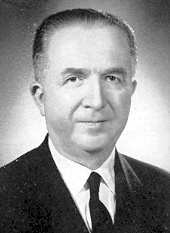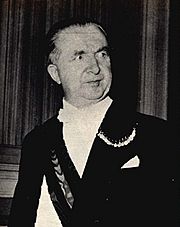Giuseppe Pella facts for kids
Quick facts for kids
Giuseppe Pella
|
|||||||||||||||||||||||||||||||||||||||||||||||||||||||||||||||||||||||||||||||||||||
|---|---|---|---|---|---|---|---|---|---|---|---|---|---|---|---|---|---|---|---|---|---|---|---|---|---|---|---|---|---|---|---|---|---|---|---|---|---|---|---|---|---|---|---|---|---|---|---|---|---|---|---|---|---|---|---|---|---|---|---|---|---|---|---|---|---|---|---|---|---|---|---|---|---|---|---|---|---|---|---|---|---|---|---|---|---|
 |
|||||||||||||||||||||||||||||||||||||||||||||||||||||||||||||||||||||||||||||||||||||
| Prime Minister of Italy | |||||||||||||||||||||||||||||||||||||||||||||||||||||||||||||||||||||||||||||||||||||
| In office 17 August 1953 – 19 January 1954 |
|||||||||||||||||||||||||||||||||||||||||||||||||||||||||||||||||||||||||||||||||||||
| President | Luigi Einaudi | ||||||||||||||||||||||||||||||||||||||||||||||||||||||||||||||||||||||||||||||||||||
| Preceded by | Alcide De Gasperi | ||||||||||||||||||||||||||||||||||||||||||||||||||||||||||||||||||||||||||||||||||||
| Succeeded by | Amintore Fanfani | ||||||||||||||||||||||||||||||||||||||||||||||||||||||||||||||||||||||||||||||||||||
| Deputy Prime Minister of Italy | |||||||||||||||||||||||||||||||||||||||||||||||||||||||||||||||||||||||||||||||||||||
| In office 20 May 1957 – 2 July 1958 |
|||||||||||||||||||||||||||||||||||||||||||||||||||||||||||||||||||||||||||||||||||||
| Prime Minister | Adone Zoli | ||||||||||||||||||||||||||||||||||||||||||||||||||||||||||||||||||||||||||||||||||||
| Preceded by | Giuseppe Saragat | ||||||||||||||||||||||||||||||||||||||||||||||||||||||||||||||||||||||||||||||||||||
| Succeeded by | Antonio Segni | ||||||||||||||||||||||||||||||||||||||||||||||||||||||||||||||||||||||||||||||||||||
| President of the Common Assembly | |||||||||||||||||||||||||||||||||||||||||||||||||||||||||||||||||||||||||||||||||||||
| In office 29 November 1954 – 27 November 1956 |
|||||||||||||||||||||||||||||||||||||||||||||||||||||||||||||||||||||||||||||||||||||
| Preceded by | Alcide De Gasperi | ||||||||||||||||||||||||||||||||||||||||||||||||||||||||||||||||||||||||||||||||||||
| Succeeded by | Hans Furler | ||||||||||||||||||||||||||||||||||||||||||||||||||||||||||||||||||||||||||||||||||||
|
|||||||||||||||||||||||||||||||||||||||||||||||||||||||||||||||||||||||||||||||||||||
|
|||||||||||||||||||||||||||||||||||||||||||||||||||||||||||||||||||||||||||||||||||||
| Personal details | |||||||||||||||||||||||||||||||||||||||||||||||||||||||||||||||||||||||||||||||||||||
| Born | 18 April 1902 Valdengo, Piedmont, Kingdom of Italy |
||||||||||||||||||||||||||||||||||||||||||||||||||||||||||||||||||||||||||||||||||||
| Died | 31 May 1981 (aged 79) Rome, Lazio, Italy |
||||||||||||||||||||||||||||||||||||||||||||||||||||||||||||||||||||||||||||||||||||
| Political party | Christian Democracy | ||||||||||||||||||||||||||||||||||||||||||||||||||||||||||||||||||||||||||||||||||||
| Spouse |
Ines Cardolle
(m. 1934) |
||||||||||||||||||||||||||||||||||||||||||||||||||||||||||||||||||||||||||||||||||||
| Children | 1 | ||||||||||||||||||||||||||||||||||||||||||||||||||||||||||||||||||||||||||||||||||||
| Occupation | Tax advisor, politician | ||||||||||||||||||||||||||||||||||||||||||||||||||||||||||||||||||||||||||||||||||||
Giuseppe Pella (born April 18, 1902 – died May 31, 1981) was an important Italian politician. He was a member of the Christian Democratic party. Pella served as the 31st Prime Minister of Italy from 1953 to 1954. He also held several other important roles. These included being the Minister of Treasury, Minister of Budget, and Minister of Foreign Affairs during the 1950s and early 1960s. From 1954 to 1956, Pella was the President of the European Parliament.
Many people believe Pella was one of the most important politicians in Italy after World War II. His economic ideas, which focused on less government control, helped Italy rebuild and led to a period of great economic growth. This period is known as the Italian economic miracle.
Contents
Early Life and Political Beginnings
Giuseppe Pella was born in Valdengo, a town in the Piedmont region of Italy. His parents, Luigi Pella and Viglielmina Bona, were sharecroppers, meaning they farmed land owned by someone else and paid rent with a share of their crops.
Pella studied hard and graduated from the Royal Superior Institute of Turin in 1924 with a degree in Economy and Commerce. He became a professor who taught accounting at important universities like the Sapienza University of Rome and the University of Turin. He also worked as a tax advisor, helping people with their taxes, and as an auditor, checking financial records.
Life During Fascist Rule
During the time of Benito Mussolini's rule, Pella had to join the National Fascist Party. This was necessary for him to continue his work as a tax advisor and professor. As a member, he was given some local roles, like helping to organize the city's money in Biella.
In 1934, Pella married Ines Maria Cardolle. They had one daughter named Wanda, who was born in 1938.
Joining the Resistance and Post-War Politics
During the Italian Civil War, Pella secretly worked with the National Liberation Committee (CLN). This group was part of the Italian resistance movement that fought against the German occupation of Italy after the war.
After World War II ended, Pella joined the Christian Democracy party. This party was led by Alcide De Gasperi. Pella quickly became a key member of the party's right wing. After the 1946 election, he became a member of the Constituent Assembly of Italy. This assembly helped write Italy's new constitution. In July 1946, he became an under-secretary of Finances. Later, in June 1947, he was appointed Minister of Finance.
Leading Italy's Economy
From May 1948 to January 1954, Giuseppe Pella served as the Minister of Budget. He was also the Minister of Treasury for much of this time. As a minister, he believed in economic policies that allowed businesses to operate with less government control. He also focused on controlling the amount of money in circulation.
These ideas were not popular with everyone. The Italian Communist Party and the Italian Socialist Party strongly disagreed with him. Even some members of his own Christian Democracy party criticized his approach. American experts from the Marshall Plan, which was a program of financial aid from the United States to help Europe rebuild, were surprised. Pella used the aid money to fix Italy's public finances and stabilize the government's budget, rather than on large public spending projects. He followed the ideas of Luigi Einaudi, another important Italian economist.
Serving as Prime Minister
In 1953, Italy held a general election. The government tried to change the election rules to give the winning coalition a huge number of seats. However, the government coalition did not get enough votes to use this special rule. Even though they won the election and had enough seats to govern, the failure to win a supermajority caused problems within the ruling coalition.
Because of these tensions, the previous Prime Minister, Alcide De Gasperi, had to resign. On August 17, 1953, President Einaudi chose Giuseppe Pella to be the new Prime Minister of Italy. Pella's government was seen as a temporary one, mainly focused on approving the country's budget. As Prime Minister, he also temporarily held the roles of Minister of Budget and Minister of Foreign Affairs.
The Trieste Crisis
Pella faced criticism when he made strong nationalistic statements about the Free Territory of Trieste. This area was disputed between Italy and Yugoslavia. The leader of Yugoslavia, Josip Broz Tito, said he would invade Trieste if it was given to Italy. Pella responded by threatening to send Italian troops to the border. This situation could have led to a military conflict. However, other Western countries worked hard to find a diplomatic solution and calm things down.
Pella's strong actions caused different reactions in Italy. Some parties, like the Monarchist National Party and the neo-fascist Italian Social Movement, supported him. But leftist parties, especially the communists, accused him of being too nationalistic. Many people in the public, however, saw him as a patriot and a brave leader.
On January 12, 1954, after only five months, Pella resigned. This happened after a disagreement with members of his own party about appointing a new Minister of Agriculture.
After the Premiership
After his time as Prime Minister, Giuseppe Pella continued his political career. In November 1954, he was elected President of the Common Assembly. This was an early version of the European Parliament, part of the European Coal and Steel Community (ECSC). He held this position until November 1956. Pella strongly believed in a united Europe. He said that Europe should be built "not against nations but with the sincere collaboration of nations."
In 1954, Pella helped create a right-wing group within the Christian Democracy party. In 1955, he played a key role in helping Giovanni Gronchi become President of Italy.
Pella later served as Minister of Foreign Affairs again from 1957 to 1958 and from 1959 to 1960. He was also Deputy Prime Minister in 1957-1958. From 1960 to 1962, he was the Minister of Budget once more.
Pella did not agree with his party's alliance with the Socialist Party in 1962, so he stepped back from some political roles. He later became president of the Senate Foreign Affairs Committee from 1968 to 1972. He briefly returned to the government as Finance Minister in 1972, but his government did not gain enough support from Parliament.
Pella left politics in 1976. He continued to lead several professional associations, including those for insurance and tax advisors. He also founded and led "Piemonte Italia," an institute that studied the regional economy.
Giuseppe Pella passed away in Rome on May 31, 1981, at the age of 79.
Images for kids
See also
 In Spanish: Giuseppe Pella para niños
In Spanish: Giuseppe Pella para niños






